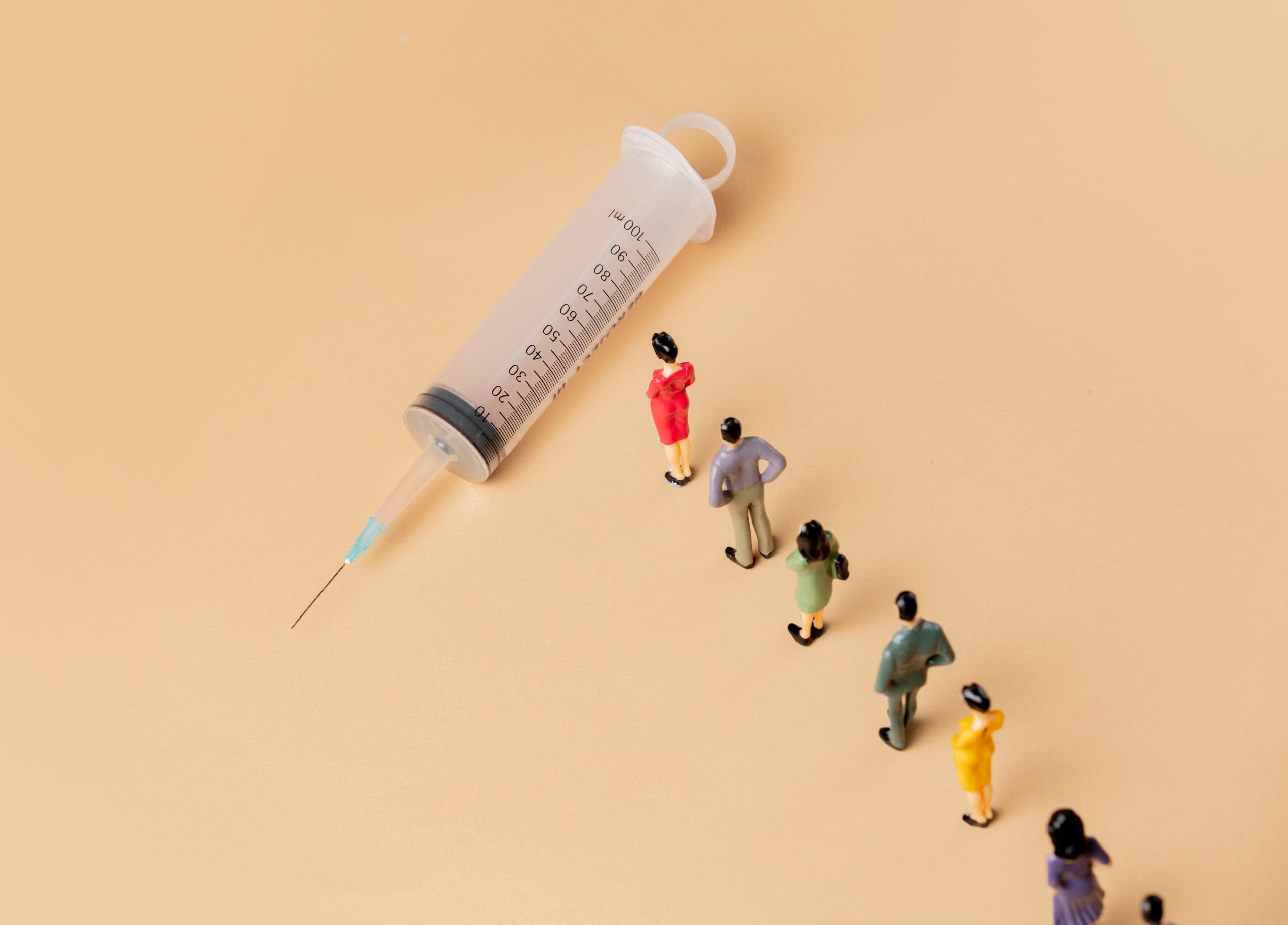Vaccines: Two centuries of skepticism
الارتياب من اللقاحات وربطها بنظريات المؤامرة قصة طويلة عمرها أكثر من مئتي عام
AFP
Paris: Wariness and outright hostility to vaccines did not start with Covid-19, they date back to the 18th century when the first shots were given.
From real fears sparked by side-effects, to fake studies and conspiracy theories, we take a look at anti-vax sentiment over the ages:
– 1796: First jab, first fears –
Smallpox killed or disfigured countless millions for centuries before it was eradicated in 1980 through vaccination.
In 1796 the English physician Edward Jenner came up with the idea of using the milder cowpox virus on a child to stimulate immune response after he noticed milkmaids rarely got smallpox.
The process — coined “vaccinus” by Jenner (from cow in Latin) — was successful, but from the outset it provoked scepticism and fear.
Before Jenner a riskier method of inoculation known as “variolation” existed for smallpox, introduced to Europe from Ottoman Turkey by the English writer and wit Lady Mary Wortley Montagu.
– 1853: Mandatory shot –
In Britain the smallpox vaccine became compulsory for children in 1853, making it the first-ever mandatory jab and triggering strong resistance.
Opponents objected on religious grounds, raised concerns over the dangers of injecting animal products, and claimed individual freedoms were being infringed.
A “conscience clause” was introduced in 1898 allowing sceptics to avoid vaccination.
– 1885: Pasteur and rabies –
At the end of the 19th century, the French biologist Louis Pasteur developed a vaccine against rabies by infecting rabbits with a weakened form of the virus.
But again the process sparked mistrust and Pasteur was accused of seeking to profit from his discovery.
– 1920s: Vaccines heyday –
Vaccines flourished in the 1920s — shots were rolled out against tuberculosis with the BCG in 1921, diphtheria in 1923, tetanus in 1926 and whooping cough in 1926.
It was also the decade that aluminium salts began to be used to increase the effectiveness of vaccines.
But more than half a century later these salts became the source of suspicion, with a condition causing lesions and fatigue called macrophagic myofasciitis thought to be caused by them.
– 1998: Fake autism study –
A study published in the top medical journal The Lancet in 1998 suggested there was a link between autism and the measles, mumps and rubella shot known as the MMR vaccine.
The paper by Andrew Wakefield and colleagues was revealed years later to be a fraud and retracted by the journal, with Wakefield struck off the medical register.
Despite subsequent studies demonstrating the absence of any such link, the bogus paper is still a reference for anti-vaxxers and it left its mark.
Measles killed 207,500 people in 2019, a jump of 50 percent since 2016 with the World Health Organization warning that vaccine coverage is falling globally.
– 2009: Swine flu scare –
The discovery in 2009 of “Swine flu”, or H1N1, caused by a virus of the same family as the deadly Spanish flu, caused great alarm.
But H1N1 was not as deadly as first feared and millions of vaccine doses produced to fight it were destroyed, fuelling mistrust towards vaccination campaigns.
Matters were made worse by the discovery that one of the vaccines, Pandemrix, raised the risk of narcolepsy.
Of 5.5 million people given the vaccine in Sweden, 440 had to be compensated after developing the sleep disorder.
– 2020: Polio conspiracy theories –
Eradicated in Africa since August 2020 thanks to vaccines, polio is still a scourge in Pakistan and Afghanistan where the disease, which causes paralysis in young children, remains endemic.
Anti-vaccine conspiracy theories have allowed it to continue to destroy lives.
In Afghanistan, the Taliban banned vaccine campaigns, calling them a Western plot to sterilise Muslim children.
أ ف ب
باريس: منذ بدء اكتشاف اللقاحات، أو ظهور فكرة تعزيز المناعة من خلال إدخال الفيروس إلى الجسم، بدأ الارتياب من التلقيح، أو حتى الرفض القاطع له من فئة من السكان. فما نشاهده اليوم من مظاهرات في بلدان عدة احتجاجا على لقاحات فيروس كورونا ليس وليد الساعة، بل عمره أكثر من مئتي عام.
ليس الارتياب من التلقيح، أو حتى الرفض القاطع له من فئة من السكان، وليد وباء كوفيد-19، بل “هو بقِدَم اللقاحات بذاتها”، على حد قول مؤرخ الشؤون الصحية باتريك زيلبرمان.
1796: فكرة جدلية
شكل الجدري طوال قرون مرضا فيروسيا قويا قبل القضاء عليه سنة 1980 بفضل التطعيم. وفي العام 1796، خطرت على بال طبيب بريطاني هو إدوارد جينير فكرة تلقيح طفل بجرعة حميدة من المرض لتعزيز تفاعله المناعي.
وقد أتى هذا الأسلوب بثماره لكنه أثار منذ البداية ارتيابا ومخاوف. وكان أسلوب تلقيح مستمد من واقع التجربة قائما قبل التجارب على الجدري، وكان بدوره محطّ جدل محموم في أوروبا في القرن الثامن عشر.
1853: أول لقاح إلزامي
أصبح اللقاح ضد الجدري في بريطانيا إلزاميا للأطفال في 1853. وقد أثارت إلزامية التطعيم هذه معارضة شرسة.
واعتبر معارضو هذه الفكرة أن “خطر” تلقيح منتجات مشتقة من حيوانات أو بـ”دواع دينية” أو بـ”انتهاك الحريات الفردية”، بحسب ما ذكرت الباحثتان آنيك غيموزان وماريون ماتيو في كتاب “فاكسيناسيون: أغريسيون أو بروتيكسيون؟” (التلقيح: اعتداء أو حماية؟) الصادر عن مركز “إنسرن” ودار “لو موسكادييه”.
وقد أضيف “بند الضمير” إلى القانون البريطاني سنة 1898 لإعفاء المترددين من التطعيم.
1885: باستور وداء الكَلَب
أما في نهاية القرن التاسع عشر، فقد طور لويس باستور لقاحا ضد داء الكَلَب بالاستناد إلى سلالة مخفّفة من الفيروس، لكن هذا الأسلوب كان أيضا محط ريبة واتهم باستور بالسعي إلى كسب أرباح من خلال تصنيع “كَلَب مخبري”.
1920: بدء تكاثر اللقاحات
مع بداية القرن العشرين/ تكاثرت اللقاحات، مثل اللقاحات ضد السل (“بي سي جي” 1921) فالخناق (دفتريا 1923) ثم الكزاز (1926) والسعال الديكي (1926). وفي هذه الفترة بالتحديد، بدأ استخدام أملاح الألومينيوم كمعزز لفعالية اللقاحات.
وبعد أكثر من نصف قرن، باتت هذه الأملاح موضع شك واتُّهمت بالتسبب بأمراض.
1998: دراسة زائفة وتشكيك كبير
في العام 1998، اعتبرت دراسة نُشرت في مجلة “ذي لانست” الطبية العريقة وجود رابط بين اللقاح المضاد للحصبة والنكاف والحميراء، ومرض التوحد. لكن تبين في نهاية المطاف أن الدراسة “ملفقة” من صاحبها أندرو ويكفيلد. ولم يفلح لا البيان الرسمي الذي أصدرته المجلة لدحض هذه النتائج ولا الأعمال الكثيرة اللاحقة التي أثبتت عدم وجود رابط من هذا القبيل في تبديد المخاوف.
وما زالت هذه الدراسة حجة غالبا ما يستند إليها مناهضو التطعيم لتبرير موقفهم. وهذا “التشكيك في جدوى اللقاحات” يؤدي إلى “معاودة ظهور بعض الأمراض المعدية”، وفق ما كشف باتريك زيلبرمن في كتابه “لا غير دي فاكسان” (حرب اللقاحات).
وقد أودت الحصبة بحياة 207500 شخص في العالم سنة 2019، في حصيلة هي أعلى بخمسين في المئة من تلك المسجّلة سنة 2016، في ظل انحسار التغطية اللقاحية، بحسب منظمة الصحة العالمية.
2009: فشل التلقيح ضدّ “إتش1إن1”
في العام 2009، دفع وباء إنفلونزا “اتش1ان1” الناجم عن فيروس من السلالة عينها لذاك المسبّب للإنفلونزا الإسبانية سنة 1918 منظمة الصحة العالمية إلى دقّ ناقوس الخطر. ونُظّمت حملات تطعيم على نطاق واسع، لكن تبين في نهاية المطاف أن الجائحة أقل خطورة مما كان متوقعا.
ورُميت ملايين الجرعات وزادت انتقادات سوء الإدارة من الارتياب السائد، خصوصا أن أحد اللقاحات المعتمد، وهو “باندمريكس”، يزيد من خطر مرض النوم القهري (ناركوليبسي).
وفي السويد، حصل 440 شخصا من الأشخاص الملّقحين البالغ عددهم 5,5 ملايين على تعويضات من الدولة إثر إصابتهم بهذا المرض.
2020: شلل الأطفال ونظرية المؤامرة
ظل شلل الأطفال الذي تم القضاء عليه في أفريقيا بشكل تام في آب/أغسطس 2020 بحسب البيانات الرسمية، منتشرا في آسيا وتحديدا في باكستان وأفغانستان.
ويعزى فشل حملات التلقيح إلى ارتياب سكان المناطق الريفية والانقياد وراء نظريات المؤامرة. وفي أفغانستان، حظرت حركة “طالبان” هذه الحملات واصفة إياها بمؤامرة من تدبير الغرب لجعل الأطفال المسلمين عقيمين.




